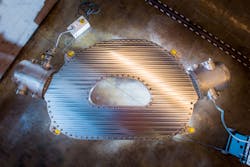MIT Spinoff focuses on Fusion Energy Future with new Campus
A company which was spun out of fusion energy work done by the Massachusetts Institute of Technology has opened a new campus and plans to have a commercial fusion energy power plant operational in about two years.
Commonwealth Fusion Systems (CFS) has opened a nearly 50-acre campus in Devens, Massachusetts to support the development and deployment of commercial fusion energy.
The Phase 1 development of the new campus includes the construction of a compact tokamak fusion device called SPARC, which is based on proven tokamak science and HTS technology. SPARC is currently under construction and is designed to produce over 100 MW of fusion power. It is expected to be operational in 2025, with net energy achieved soon thereafter, the company hopes.
According to CFS, SPARC will pave the way for the first fusion power plant, ARC, which is expected to commence feeding energy into the grid in the early 2030s.
The new campus also includes an advanced manufacturing factory for CFS’ high-temperature superconducting (HTS) magnets that enable smaller, lower-cost, and faster tokamak devices. The manufacturing facility is expected to support both the SPARC fusion device and the first commercial ARC fusion power plants, helping to address climate change with speed and scale.
Additionally, the campus houses the company’s corporate headquarters, which employs more than 430 people.
“The opening of this campus marks an important moment as we continue to accelerate towards commercially, globally deployable fusion energy,” Bob Mumgaard, CEO of CFS, said. “This site brings together our team, the proven and next stage technologies, the advanced manufacturing capabilities, and the demonstration of actual fusion performance at the scale required to bring fusion energy off the lab bench and to the market.”
CFS is a private company that spun out of MIT’s Plasma Science and Fusion Center in 2018 and is backed by more than $2 billion from clean energy investors. The company uses magnetic confinement for fusion. In 2021, CFS and MIT demonstrated a 20 tesla HTS magnet, which enables CFS to combine proven science with new innovation to develop commercial fusion energy systems.
Other entities both in the U.S. and internationally are pursuing advancements in nuclear fusion, in which lasers are aimed at a plasma target usually made up of hydrogen and helium. Last year, a team at the U.S. Lawrence Livermore National Lab achieved a net energy gain with a fusion experiment.
“Fusion is entering the transition from exciting science to game changing energy,” said Mumgaard. “The field is unrecognizable to what it was only years ago and it is exciting to think of what we’ll show over the next few years on the path to commercially viable fusion power plants in time to make a difference.”
The company plans to expand the campus to include additional facilities for advanced R&D and future manufacturing capabilities for ARC power plants.
About the Author
EnergyTech Staff
Rod Walton is senior editor for EnergyTech.com. He has spent 17 years covering the energy industry as a newspaper and trade journalist.
Walton formerly was energy writer and business editor at the Tulsa World. Later, he spent six years covering the electricity power sector for Pennwell and Clarion Events. He joined Endeavor and EnergyTech in November 2021.
He can be reached at [email protected].
EnergyTech is focused on the mission critical and large-scale energy users and their sustainability and resiliency goals. These include the commercial and industrial sectors, as well as the military, universities, data centers and microgrids.
Many large-scale energy users such as Fortune 500 companies, and mission-critical users such as military bases, universities, healthcare facilities, public safety and data centers, shifting their energy priorities to reach net-zero carbon goals within the coming decades. These include plans for renewable energy power purchase agreements, but also on-site resiliency projects such as microgrids, combined heat and power, rooftop solar, energy storage, digitalization and building efficiency upgrades.
